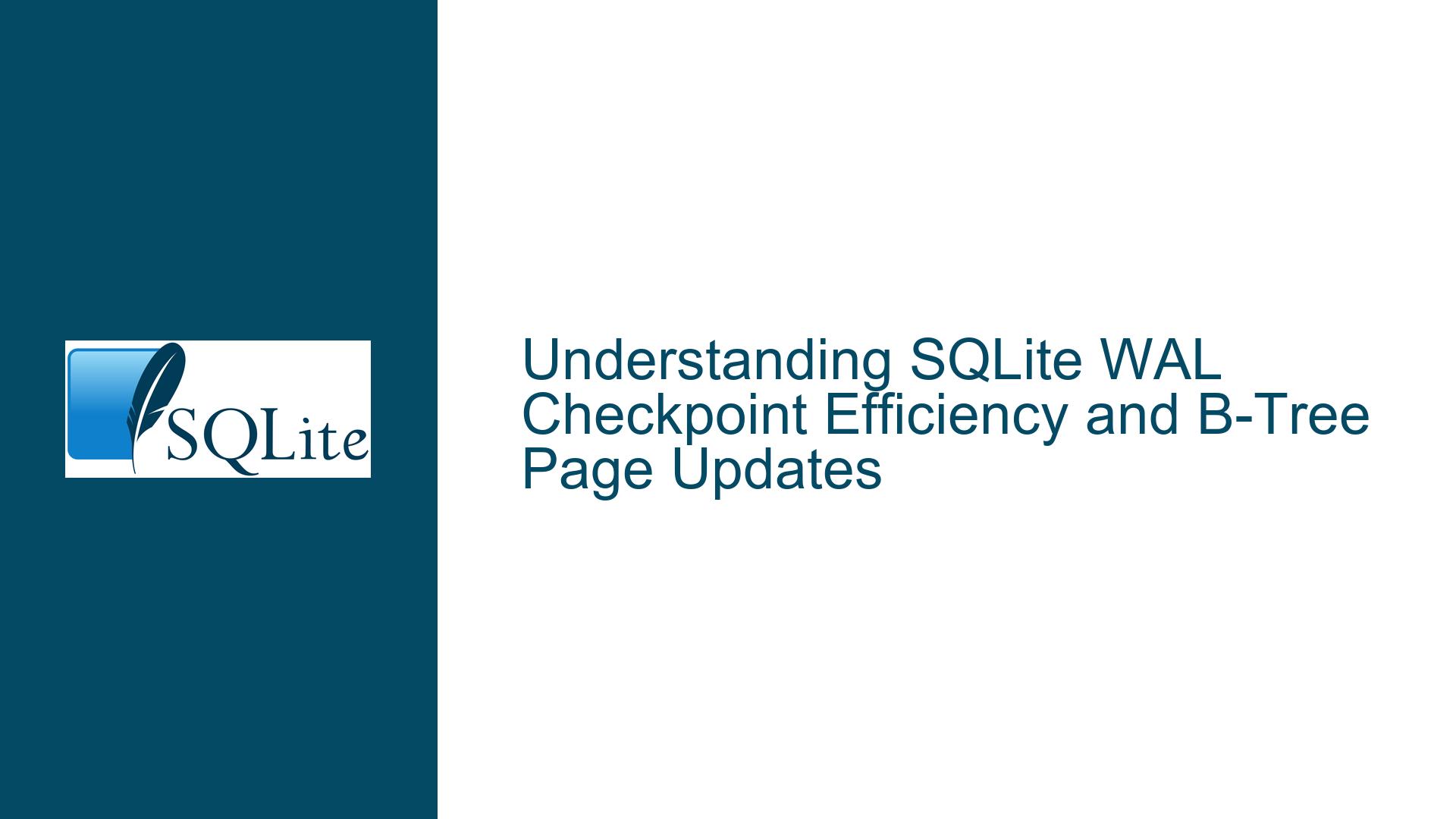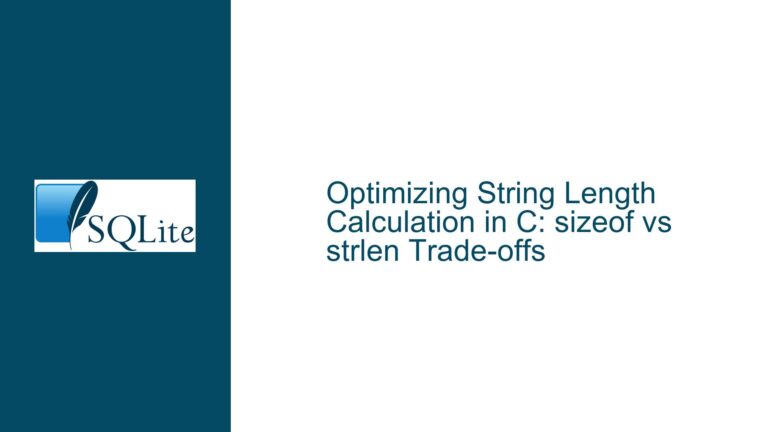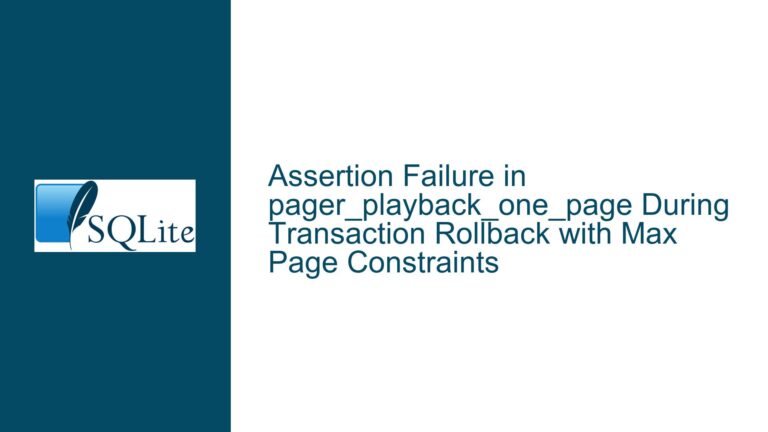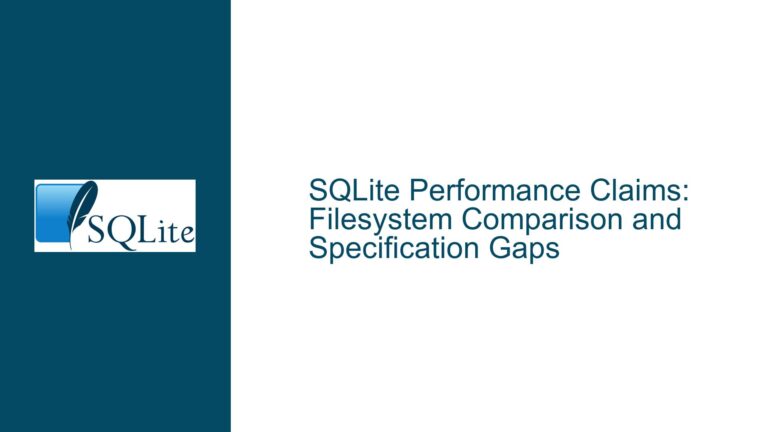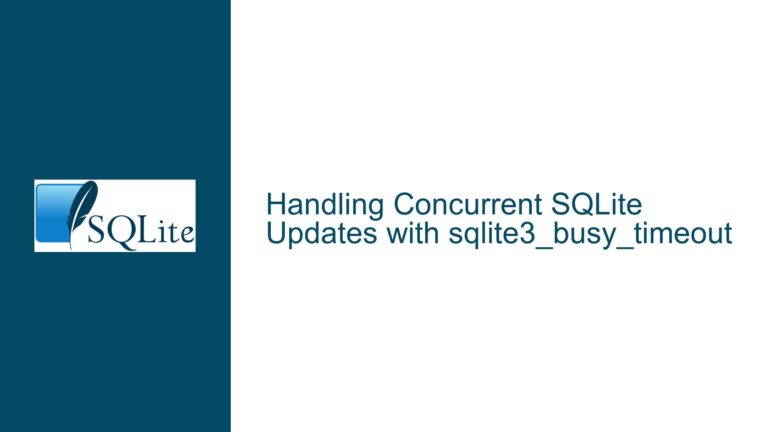SQLite WAL Checkpoint Efficiency and B-Tree Page Updates
Mechanics of SQLite WAL Checkpoints and B-Tree Page Modifications
Issue Overview: WAL Checkpoint Overhead and Proposed Page Allocation Strategy
The core issue revolves around optimizing SQLite’s Write-Ahead Logging (WAL) mechanism to reduce checkpoint overhead. The original proposal suggests modifying how pages are written during transactions: instead of appending all changed pages to the WAL file, the idea is to write modified pages directly to unused ("free") regions in the main database file. During commit, only the uppermost B-Tree index pages (e.g., root or parent nodes) and the free-list tail would be written to the WAL. Checkpointing would then involve overwriting these top-level pages in the main database, thereby "linking" the new pages (already in the main file) into the B-Tree structure. This approach aims to minimize checkpoint I/O by reducing the number of pages copied from the WAL to the main database.
However, this strategy introduces complexities. SQLite’s WAL design relies on copy-on-write semantics: all changes are first written to the WAL, and readers see a consistent snapshot by referencing the WAL’s frame headers. If modified pages are instead written directly to the main database file, readers must resolve page pointers across both the main database and WAL, which complicates snapshot isolation. Additionally, B-Tree page hierarchies are interdependent: modifying a leaf page requires updating its parent, grandparent, and potentially the root page. If these updates are scattered between the WAL and main database, ensuring atomic commits and read consistency becomes non-trivial.
Key challenges include:
- Atomicity of Commits: A transaction’s changes must appear atomically. If some pages are in the main database and others in the WAL, readers might see partial updates.
- Page Tracking: Readers must determine which version of a page to use (main database vs. WAL) without scanning the entire file.
- Fragmentation: Writing new pages to free spaces in the main database could fragment the file, increasing seek times.
- Free List Management: The free-list tail (tracking unused pages) must be updated atomically, requiring coordination with WAL entries.
Root Causes: B-Tree Page Hierarchy and WAL Semantics
The proposed optimization conflicts with SQLite’s B-Tree and WAL architecture in three critical ways:
B-Tree Page Interdependencies
In SQLite, each table and index is stored as a B-Tree. Pages are linked hierarchically: leaf nodes contain data, interior nodes route to leaves, and the root page anchors the tree. Modifying a leaf page requires updating its parent to point to the new leaf. If the parent itself is modified (e.g., to reference a new child), its parent must also be updated, creating a chain up to the root.Writing modified leaf pages to the main database file (instead of the WAL) does not eliminate checkpoint overhead. The root or intermediate pages must still be updated in the main database to point to the new leaves. These updates are not atomic: if a checkpoint fails midway, the B-Tree could be left in an inconsistent state.
WAL Frame Consistency
SQLite’s WAL guarantees snapshot isolation by assigning each transaction a "frame offset" in the WAL file. Readers use this offset to determine which pages to load. If modified pages are written to the main database, the WAL must still track which pages in the main file are valid for a given snapshot. This requires additional metadata, increasing the complexity of the WAL index (stored in the -shm file).Free List Synchronization
The free-list (a linked list of unused pages in the main database) is managed as a B-Tree. When new pages are allocated in the main database, the free-list’s tail pointer must be updated. If this update is written to the WAL, concurrent transactions could overwrite each other’s free-list changes, leading to data corruption.Checkpoint Locking
Checkpointing in SQLite requires an exclusive lock to overwrite pages in the main database. If new pages are already in the main file, checkpointing still needs to update B-Tree roots and free-list tails. This lock contention remains a bottleneck, negating potential gains from reduced I/O.
Resolving WAL Checkpoint and Page Update Conflicts
1. Understanding SQLite’s WAL Semantics
SQLite’s WAL works as follows:
- Write Phase: During a transaction, modified pages are appended to the WAL.
- Commit Phase: A commit record is written to the WAL header, marking the transaction as durable.
- Checkpoint Phase: Pages from the WAL are copied back to the main database.
The proposed optimization merges the write and checkpoint phases by writing new pages directly to the main database. However, this conflates two distinct roles of the WAL:
- Durability: The WAL ensures transactions survive crashes.
- Snapshot Isolation: The WAL provides readers with a consistent view of the database.
By writing to the main database early, durability is still satisfied, but snapshot isolation is compromised. Readers must now reconcile pages from the main database (which may include uncommitted changes) with the WAL.
2. B-Tree Page Hierarchy Updates
Consider a B-Tree where a leaf page is modified and written to a new location in the main database. To link this page into the B-Tree:
- The parent page must be updated to point to the new leaf.
- If the parent page is also moved, its parent must be updated, propagating up to the root.
These updates form a write chain. In SQLite’s current design, this chain is written to the WAL, ensuring atomicity. If the chain is split between the WAL and main database, a crash during checkpointing could leave the B-Tree in an inconsistent state.
3. Free List Management
The free-list is a critical structure for tracking unused pages. If new pages are allocated in the main database during a transaction, the free-list’s tail must be updated. This update must be atomic: if two transactions allocate pages concurrently, their free-list updates must not interfere.
Writing free-list changes to the WAL ensures atomicity. If free-list updates are instead written to the main database, coordination requires fine-grained locking, which conflicts with SQLite’s lock-free reader design.
4. Checkpoint Optimization Strategies
To reduce checkpoint overhead without altering the WAL:
- Incremental Checkpointing: Use
PRAGMA wal_checkpoint(TRUNCATE)to periodically checkpoint the WAL in the background. - Batch WAL Writes: Group multiple transactions into a single WAL frame to amortize fsync costs.
- SSD Optimization: On SSDs, random writes are less penalized. Adjust
PRAGMA page_sizeandPRAGMA cache_sizeto match the SSD’s block size.
5. Alternative Approaches
If minimizing checkpoint I/O is critical, consider:
- In-Memory Databases: Use
:memory:or RAM disks for transient data. - Alternative Storage Engines: Use a database with copy-on-write B-Trees (e.g., LMDB), though this sacrifices SQL compatibility.
- Custom VFS: Implement a virtual file system layer to redirect WAL writes, though this is complex and error-prone.
6. Why SQLite’s WAL Works as Designed
SQLite’s WAL balances read concurrency, write durability, and implementation simplicity. By isolating writes to the WAL, readers can access the main database without locks. Checkpointing is a deliberate trade-off: it postpones main database updates to optimize for write throughput. Altering this design would require rearchitecting SQLite’s core, which is beyond the scope of configuration or extension.
This analysis underscores the inherent tension between checkpoint efficiency and SQLite’s architectural guarantees. While the proposed optimization is theoretically appealing, it conflicts with the database’s reliance on atomic WAL updates and hierarchical B-Tree integrity. Developers are advised to leverage existing checkpoint tuning parameters or explore alternative storage solutions if WAL overhead is prohibitive.
